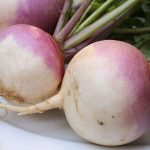 From the eighth to the sixteenth century in England, and even today in Scotland, turnips were called neeps, a word deriving from the Latin name of the vegetable, napus. In the sixteenth century, for some unknown reason, this name came to be seen as inadequate and therefore neep was compounded with another word to form turnip. This other word was likely either the English word turn or its French equivalent tour, the idea being that a turnip is so round it appears to have been turned on a lathe. The plant known since the fourteenth century as the turnsole—the berries of which produce a purple dye once used to colour jellies—likewise derives part of its name from the word turn, but for a different reason: throughout the day its flowers turn as they follow the sun across the sky.
From the eighth to the sixteenth century in England, and even today in Scotland, turnips were called neeps, a word deriving from the Latin name of the vegetable, napus. In the sixteenth century, for some unknown reason, this name came to be seen as inadequate and therefore neep was compounded with another word to form turnip. This other word was likely either the English word turn or its French equivalent tour, the idea being that a turnip is so round it appears to have been turned on a lathe. The plant known since the fourteenth century as the turnsole—the berries of which produce a purple dye once used to colour jellies—likewise derives part of its name from the word turn, but for a different reason: throughout the day its flowers turn as they follow the sun across the sky.
Presenting a root vegetable characterized by its robust nature, turnips stand adorned with a thick skin and a flesh that ranges from white to yellow. These versatile gems grace our tables throughout the year, as they possess the admirable quality of extended storage. Embodying a bold and delightful taste, turnips exude a strong yet sweet flavor, requiring only a modest quantity to infuse stews, soups, and various other culinary creations with their distinctive essence. While imparting their culinary magic, turnips also offer a modest amount of vitamin C, further contributing to their nutritional value.
